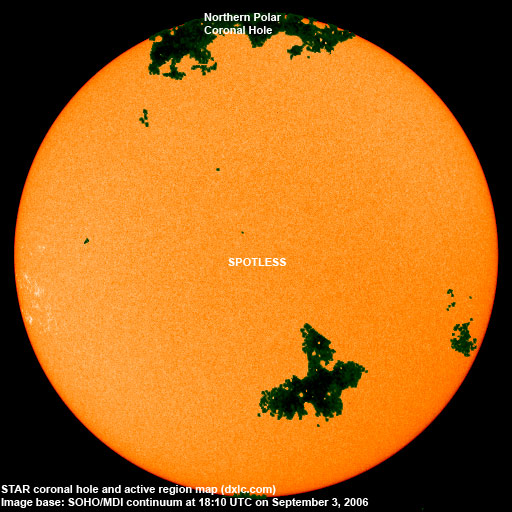

Last major update issued on September 4, 2006 at 03:35 UTC.
[Solar and
geomagnetic data - last month (updated daily)]
[Solar wind and
electron fluence charts (updated daily)]
[Solar cycles 21-23
(last update September 3, 2006)]
[Solar cycles 1-20]
[Graphical comparison
of cycles 21, 22 and 23 (last update September 3, 2006)]
[Graphical
comparison of cycles 2, 10, 13, 17, 20 and 23 (last update September 3, 2006)]
[Historical solar and
geomagnetic data charts 1954-2005 (last update March 3, 2006)]
[Archived reports (last update
August 6, 2006)]
The geomagnetic field was quiet to unsettled on September 3. Solar wind speed ranged between 405 and 486 km/s (all day average 447 km/s - increasing 4 km/s over the previous day) under the influence of a weak high speed stream from CH238. A solar wind shock was observed at SOHO at 23:22 UTC with a sudden increase in solar wind speed from 410 to 455 km/sec. The source of this unexpected shock may have been a long duration B class event in region 10906 on August 31. A type IV radio sweep was recorded in association with this event in the early evening that day.
Solar flux measured at 20h UTC on 2.8 GHz was 76.5. The planetary A index was 6 (STAR Ap - based on the mean of three hour interval ap indices: 6.4). Three hour interval K indices: 23111112 (planetary), 24223212 (Boulder).
The background x-ray flux is at the class A5 level.
At midnight the visible solar disk was spotless. The solar flare activity level was very low. No C class events were recorded during the day.
September 1-3: No obvious partly or fully Earth directed CMEs were detected in incomplete LASCO imagery.
Coronal hole history (since late October 2002)
Compare today's report to the situation one solar rotation ago:
28 days ago
27 days ago
26 days ago
A coronal hole in the southern hemisphere was probably too far south on September 3 (when it rotated across the central meridian) to become geoeffective.

Processed SOHO/EIT 284 image at 19:08 UTC on August 18. The darkest areas on the solar disk are likely coronal holes.
The geomagnetic field is expected to be quiet to minor storm on September 4 due to CME effects and quiet on September 5-8.
| Coronal holes (1) | Coronal mass ejections (2) | M and X class flares (3) |
1) Effects from a coronal hole could reach Earth
within the next 5 days. When the high speed stream has arrived the color changes to green.
2) Effects from a CME are likely to be observed at Earth within 96 hours.
3) There is a possibility of either M or X class flares within the next 48 hours.
Green: 0-20% probability, Yellow: 20-60% probability, Red: 60-100% probability.
Long distance low and medium frequency (below 2 MHz) propagation along east-west paths over high and upper middle latitudes is poor. Other than fair signals from some of the Newfoundland stations and 1660 WCNZ, only a few other stations were heard with weak signals. Propagation on long distance northeast-southwest paths is poor.

Compare to the previous day's image.
Data for all numbered solar regions according to the Solar Region Summary provided by NOAA/SEC. Comments are my own, as is the STAR spot count (spots observed at or inside a few hours before midnight) and data for regions not numbered by SEC or where SEC has observed no spots. SEC active region numbers in the table below and in the active region map above are the historic SEC/USAF numbers.
| Active region | Date numbered | SEC spot count |
STAR spot count |
Location at midnight | Area | Classification | Comment |
|---|---|---|---|---|---|---|---|
| Total spot count: | 0 | 0 | |||||
| SSN: | 0 | 0 | |||||
| Month | Average solar flux at Earth |
International sunspot number | Smoothed sunspot number |
|---|---|---|---|
| 2000.04 | 184.2 | 125.5 | 120.8 cycle 23 sunspot max. |
| 2000.07 | 202.3 | 170.1 | 119.8 |
| 2001.12 | 235.1 | 132.2 | 114.6 (-0.9) |
| 2005.07 | 96.4 | 40.1 | 29.1 (+0.3) |
| 2005.08 | 90.5 | 36.4 | 27.4 (-1.7) |
| 2005.09 | 91.1 | 21.9 | 25.8 (-1.6) |
| 2005.10 | 77.0 | 8.5 | 25.5 (-0.3) |
| 2005.11 | 86.3 | 18.0 | 24.9 (-0.6) |
| 2005.12 | 90.7 | 41.2 | 23.0 (-1.9) |
| 2006.01 | 83.4 | 15.4 | 20.8 (-2.2) |
| 2006.02 | 76.5 | 4.7 | 18.6 (-2.2) |
| 2006.03 | 75.4 | 10.8 | (17.1 predicted, -1.5) |
| 2006.04 | 89.0 | 30.2 | (16.4 predicted, -0.7) |
| 2006.05 | 80.9 | 22.2 | (15.9 predicted, -0.5) |
| 2006.06 | 76.5 | 13.9 | (14.1 predicted, -1.8) |
| 2006.07 | 75.7 | 12.2 | (12.4 predicted, -1.7) |
| 2006.08 | 79.0 | 12.9 | (11.9 predicted, -0.5) |
| 2006.09 | 76.3 (1) | 2.0 (2) | (11.9 predicted, -0.0) |
1) Running average based on the
daily 20:00 UTC observed solar flux
value at 2800 MHz.
2) Unofficial, accumulated value based on the Boulder (NOAA/SEC)
sunspot number. The official international sunspot number is typically
30-50% lower.
This report has been prepared by Jan Alvestad. It is based partly on my own observations and analysis, and partly on data from some of these solar data sources. All time references are to the UTC day. Comments and suggestions are always welcome.
| [DX-Listeners' Club] |